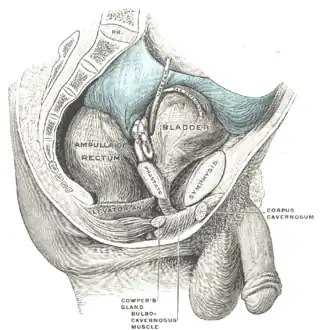| Retropubic space | |
|---|---|
 Male pelvic organs seen from right side. (Retropubic space visible but not labeled.) | |
 Vertical section of bladder, penis, and urethra. (Retropubic space visible but not labeled.) | |
| Details | |
| Location | Pelvis, between the pubic symphysis and the urinary bladder. |
| Function | Anatomical space |
| Identifiers | |
| Latin | spatium retropubicum |
| TA98 | A10.1.01.003 |
| TA2 | 3822 |
| FMA | 22060 |
| Anatomical terminology | |
Retropubic space is a potential avascular space located between the pubic symphysis and the urinary bladder. The retropubic space is a preperitoneal space, located behind the transversalis fascia and in front of peritoneum.[1]
Other names for the retropubic space are "Cave of Retzius" or "Retzius' space", named after the Swedish anatomist Anders Retzius (1796-1860).
The space is a useful landmark in different gynecological and urological surgeries.
Structure
The space is located in the pelvic region and is bounded by the following structures:[1]
- Anteriorly: Symphysis pubis
- Laterally: Pubic rami and obturator internus muscles
- Posteriorly: Urinary bladder
- Floor: Anterior vagina (in women) and proximal urethra
Function
The retropubic space is a potential space.
Compartmental pressure
The retropubic space is directly adjacent to the abdominal cavity and is hence affected with change in intra-abdominal pressure, which in turn affects the physiology of urination and continence.[2] Normally, intra-abdominal pressure is between 5 and 7 mmHg, and can reach 10 to 15 mmHg chronically in certain cases, such as in pregnant or obese patients.[3] The pressure is strongly related to body mass index and a history of previous surgical procedures. This highly elevated pressure in obese and pregnant patients is sometimes referred to as chronic intra-abdominal hypertension.[4] This pressure is relayed to the adjacent retropubic compartment and can affect the structures within.
Clinical significance
The retropubic space is a surgical landmark that has surgical significance in several gynecological and urological procedures. Access to the space is achieved by separating the rectus abdominis muscle at the mid line, and bluntly dissecting the tissue in the direction of the symphysis pubis, until reaching the peritoneum.[1]
Examples of surgeries involving the retropubic space include:
- The sling procedure. Slings are or considered the first line surgical treatment for women with stress incontinence[5]
- Artificial urinary sphincters are considered first line surgical treatment for certain types of incontinence in men[5]
- Burch colposuspension is a retropubic procedure used in treatment of urinary incontinence in women[1]
See also
References
- 1 2 3 4 "Volume 1, Chapter 86. Abdominal Operations for Urinary Stress Incontinence". www.glowm.com. Retrieved 2020-02-27.
- ↑ Cundiff, Geoffrey W (2004). "The Pathophysiology of Stress Urinary Incontinence: A Historical Perspective". Reviews in Urology. 6 (Suppl 3): S10–S18. ISSN 1523-6161. PMC 1472864. PMID 16985860.
- ↑ Sanchez, N. C.; Tenofsky, P. L.; Dort, J. M.; Shen, L. Y.; Helmer, S. D.; Smith, R. S. (March 2001). "What is normal intra-abdominal pressure?". The American Surgeon. 67 (3): 243–248. doi:10.1177/000313480106700308. ISSN 0003-1348. PMID 11270882. S2CID 24575421.
- ↑ Wilson, Alison; Longhi, James; Goldman, Charles; McNatt, Stephen (July 2010). "Intra-abdominal pressure and the morbidly obese patients: the effect of body mass index". The Journal of Trauma. 69 (1): 78–83. doi:10.1097/TA.0b013e3181e05a79. ISSN 1529-8809. PMID 20622581.
- 1 2 F.C. Burkhard, J.L.H.R. Bosch, F. Cruz, G.E. Lemack, A.K. Nambiar, N. Thiruchelvam, A. Tubaro Guidelines Associates: D. Ambühl, D.A. Bedretdinova, F. Farag, R. Lombardo, M.P. Schneider. "EAU Guidelines on Urinary Incontinence in Adults" (PDF). European Association of Urology.
{{cite journal}}: CS1 maint: multiple names: authors list (link)